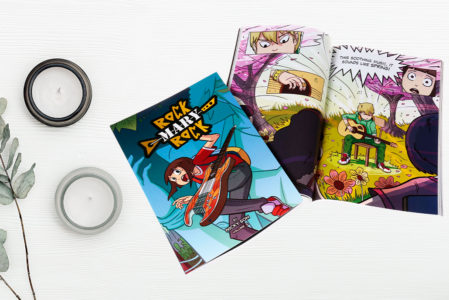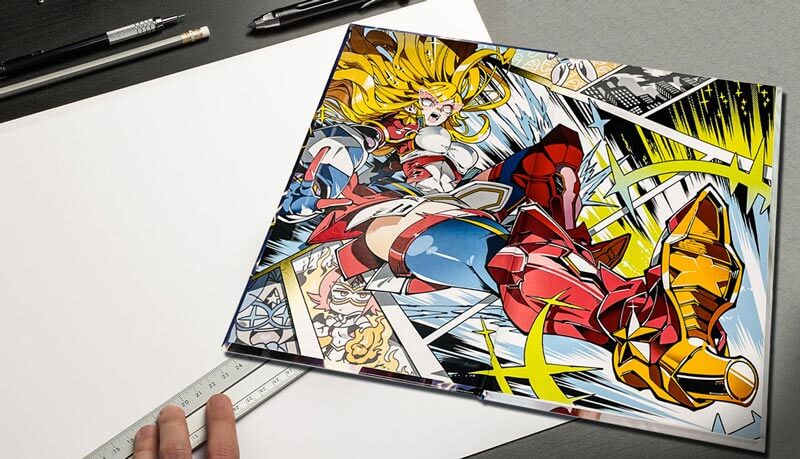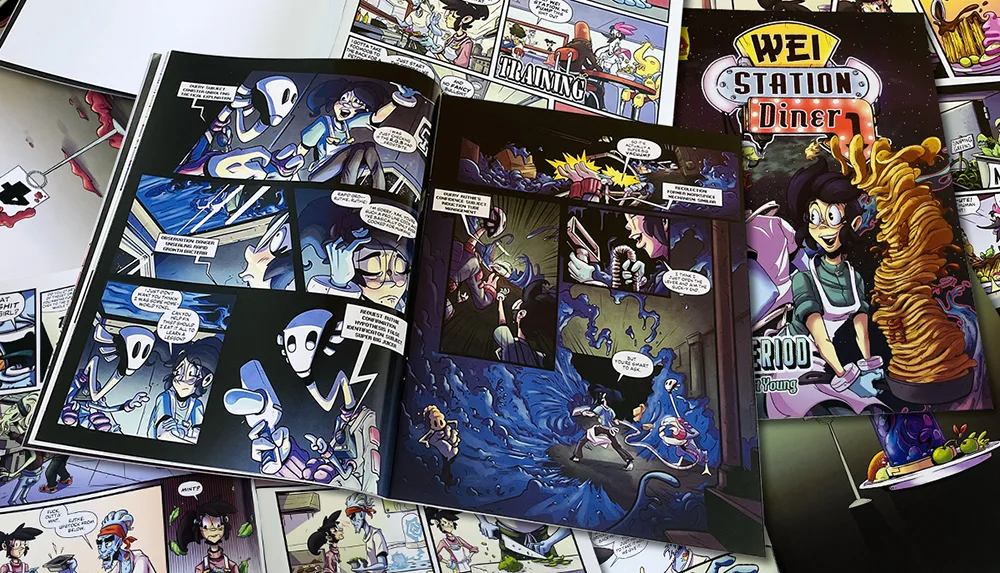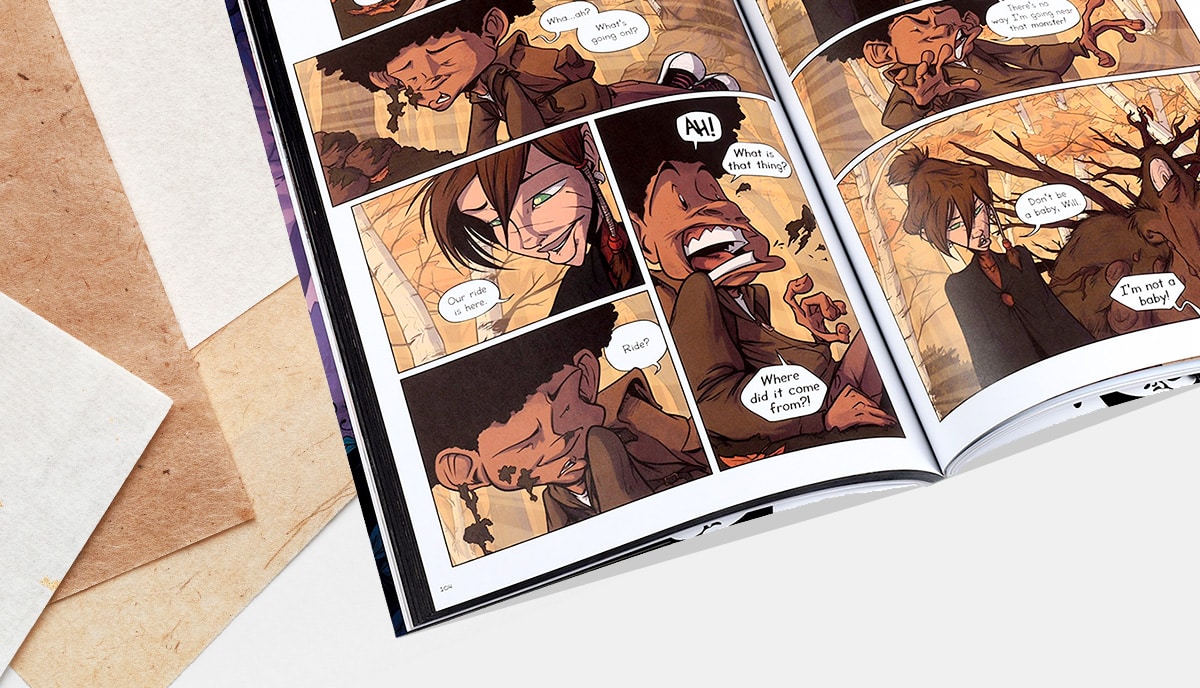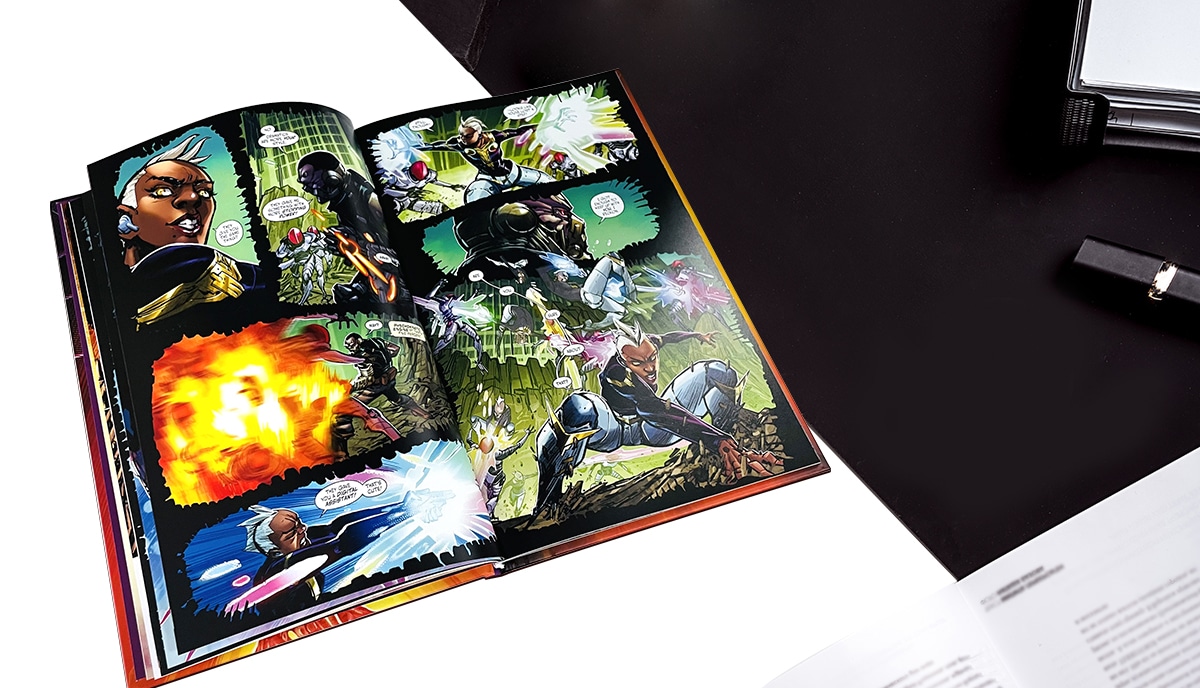
Creating a successful graphic novel series is no straightforward task, but with the right combination of passion, talent, and determination, it's possible to turn your dreams into reality. This comprehensive guide will take you through every step of the process, from crafting your story and developing your characters to designing, printing, and publishing your work. With insights from over 25 years of success in the industry and practical tips for marketing and selling your series, you'll be well on your way to becoming a successful graphic novel creator. Let's dive in!
Understanding graphic novels and their market
If you're a fan of the graphic novel format, you may think that you understand what a graphic novel is and the specifics of the market. And perhaps you do! But we know from long experience that a significant gulf can exist between being passionate about a genre, format, or style as a consumer, and knowing what you need to know to be a creator and a marketer of that product. So, let's just dig a little into this to make sure that we are clear on what we're talking about and everyone's on the same page.
What is a graphic novel?
A graphic novel is a story told through representational artwork and text organized in sequential frames and usually bound in hardcovers or paperback. The artwork is often hand-drawn—even if it's done with digital tools— and presented in a visually stunning comic-strip format, published as a self-contained book. Most graphic novels are fiction, although they may also be thematic non-fiction, biographical, or retellings of traditional myths and legends, for example. While sharing much in common with comic books, they differ and are distinguished in several important ways.
The themes, plot lines, and characters in graphic novels are typically more developed and complex than in comics and may even treat challenging, dark, political, philosophical, and other adult-oriented themes. The artwork reflects this difference, being more complex and nuanced in conception, design, and execution. They are usually longer than shorter periodical-style, saddle-stitched comic books, and as we mentioned, bound in hardcovers or “perfect bound” large format paperback style.
The growing popularity of graphic novels
In recent years, graphic novels have gained significant popularity, thanks to their unique storytelling approach and visually captivating illustrations. This has led to an increasing number of artists and writers exploring the world of graphic novels, resulting in a diverse array of stories and genres available to readers of every background and taste. Whereas a few years ago, graphic novels were considered a little “geeky” and you could only find them through specialist outlets, most of the major high street bookstores now have entire sections devoted to them and often stock hundreds if not thousands of volumes by dozens of authors. Writers such as Neil Gaiman, Marjorie Liu and Sana Takeda, Kate Beaton, and Steve Brodner—to name just a few—have helped carry the format into the mainstream; and many of the early “classic” graphic novelists such as Art Spiegelman, Lynda Barry, and Hayoa Miyazaki are enjoying refreshed interest in their re-issued works.
This growing passion for the graphic novel has boosted the options for everyone involved, including in the independent, self-publishing sector. While many famous and successful graphic novelists—both writers and artists—choose to self-publish, there's also a burgeoning community of fans of lesser known independents keen to support their favorite authors and finance the development and production of new works via crowdfunding platforms such as Kickstarter.
So, there's a huge and growing market out there for anyone with the talent and determination to carve out a niche for themselves. It's also a progressive arena which has offered traditionally marginalized groups—Black, Indigenous, LGBTQIA+, differently abled, neurodivergent authors, and more—a medium of expression and a voice. So-called minority groups are much more highly represented and supported in the graphic novel fan culture than in any other branch of mainstream publishing.
But it is, as they say, “a broad church” which includes series based on movie and TV franchises such as Star Wars, Clueless, Ghostbusters, and Buffy the Vampire Slayer. So, it needn't all be serious or dark. There's a lot of comedy and capers allowed, too! And the graphic novel demographics are equally wide ranging; the books being enjoyed by teenagers of all sexes and genders, along with adults of every class and social status. So, whatever your idea for your graphic novel series, there's almost certainly a readership out there if you can find them.
Crafting your story
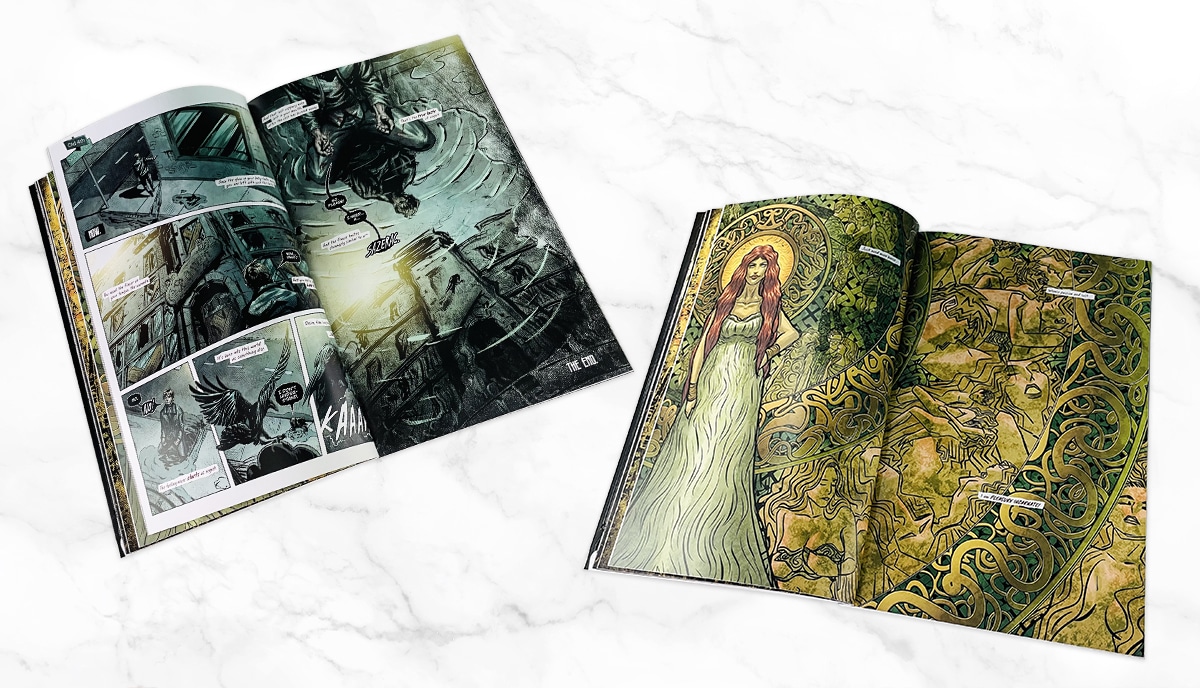
Although a graphic novel can be purely visual in content, most contain both narrative and dialogue, too. Either way, ideas, characters, and stories are just as important to the graphic novel as they are to both genre and literary fiction in traditional novel formats. So, there's a certain amount of crossover in what you need to learn, understand, and practice as a creator between the graphic novel format and the standard novel.
All the core principles of story development, character arcs, plot points, and the rest are as necessary to the graphic novel as to the text-only novel. Now, if we tried to go in depth into all of that here, we'd have a blog post longer than several books put together. But there are lots of great “how to write a novel” resources out there for anyone with access to a bookstore and who knows how to use a search engine. Still, we'll cover the basics in broad strokes to get you started in the right direction with your own research and development.
Ideation and concept development
The first step in creating a graphic novel is to come up with an interesting story idea. This can be anything from a unique twist to a classic tale to an entirely new concept that explores uncharted territory. Once you have a solid idea, start developing your story outline, ensuring that it has a clear beginning, middle, and end. But it's vitally important—if you want to create a compelling graphic novel that keeps the reader emotionally engaged from the first frame to the last—that you understand the difference between a character-driven story and an event-driven plot.
In an event-driven plot, such as you may find in a comic book, you'll have a series of exciting events and struggles for the protagonist to face and overcome in order to win the day, but these stories usually lack literary depth. What does that mean? It means that the protagonist doesn't undergo any significant change or inner transformation because of the events in the plot. A graphic novel must have this more complex level as its driving force.
So, that means that your protagonist must experience obstacles which are not only externally challenging but which challenge them at a deep personal level, forcing them to overcome their own inner demons, change, and develop as people in order either finally to get their aim or—with a tragedy—fail to obtain their objective, or only partially succeed, but having learned important life lessons on the way. Your protagonist must be a different, more developed person at the end of the story than who they were at the start. And it's the events in the plot which drive that change. This is called “the character arc”.
Creating engaging characters
So, as we've just seen, characters are the heart and soul of any successful story, and this is especially true in graphic novels. Invest time in developing well-rounded, relatable characters who will resonate with your readers. Consider their personalities, motivations, and backgrounds, and how these aspects will influence their actions throughout the story.
The key to this is to build in a central flaw in the protagonist's personality that they must overcome in order to develop sufficiently to have the power and skills needed to succeed. The flaw isn't just a quirky personality trait; it's usually something from the character's past has taught them a set of beliefs about themselves and the world; something that once helped them survive, cope, or make sense of things. But, even if it was once true, it's no longer true. It no longer works for them. Until they discover this false belief and the way it's holding them back, they can't make the transformation to enable them to move forward.
Writing a compelling script
With a strong story outline and engaging characters in place, it's time to write the script for your graphic novel. But this is where we part company with the text-based novel. Now, it's more like writing a screenplay.
Focus on crafting believable dialogue—which is not the same as realistic dialogue—while also incorporating descriptions of scenes, actions, and panel layouts. If you actually stop and listen to an actual conversation, you'll soon discover that if you were to write it out verbatim, it would be impossible to follow and probably bore the reader to death. Realistic dialogue is over long, rambling, riddled with unfinished sentences and interruptions. But believable dialogue mimics natural speech patterns while honing the content to something more precise and direct than you'll ever find in natural speech.
And a script for a graphic novel will mostly comprise descriptions of the visual elements as they are the primary mode of communication in this medium. It's much more like writing a screenplay in which it's all dialogue and directions—in broad strokes—for the visual imagery, locations, time of day, characters' actions, etc. In the movies, the director decides how to realize these ideas and fill in all the details. In a graphic novel, the artist takes care of that. Sometimes, writer and artist are the same person. More often, they are a closely collaborating team.
Be prepared to revise and edit your script multiple times as you work with the artist from the initial storyboard to more detailed frames and then the final artwork. This is not something you put together overnight! It's a long, fascinating, creative, and iterative process.
Visualizing your story
Whether you are solely the writer, solely the artist, or you're handling both vital aspects of developing a graphic novel yourself, the following information is worth knowing. As a writer, you need to understand the artist's perspective to work collaboratively. Likewise, as an artist, you need to “get inside the head” of the writer and cooperate to help realize the story's vision.
Developing your artistic style
If you are an artist or a writer-artist creating your first graphic novel, you'll soon discover that just being handy at drawing and painting isn't enough. You'll need to spend a lot of time studying your favorite graphic novels—and it's just as worthwhile to examine those you don't like—to ask yourself why you like (or don't like) what you see; how the artist conveys emotion, time shifts, viewpoint, dynamics, scene changes, rhythm and pace, and expresses the personalities and traits of the protagonist and other characters.
While it can be a very useful technique to copy your favorite artist's work as a phase of your research, you must never plagiarize, and developing your unique artistic style is a crucial component of your graphic novel's visual appeal. Experiment with different techniques, media, and styles to discover what works best for your story and characters and resonates with your natural mode of visual expression. Don't be afraid to experiment, push boundaries, and challenge conventions — this can help set your work apart from others in the market. Your style may develop and change over the course of your career, but it must be effective and consistent in each book.
Storyboarding and panel layout
Storyboarding is mapping out your story in a visual format, using panels to represent each scene or action. This helps to ensure a smooth flow and pacing throughout your graphic novel. Experiment with different panel layouts and arrangements to create dynamic, visually engaging pages. Remember that at this stage, you don't want to draw in too much detail. Most storyboards are also in gray-scale, although you can make notes about color palettes and shades. A storyboard rarely—read, never!—comes out right the first time. So, be prepared to scratch out and restart much of your first attempt.
Many professional graphic novelists go through dozens of versions before they settle on the one that will guide the final artwork. This is normal and necessary. And it's far easier to scrap a rough pencil sketch than a detailed full-color illustration. But eventually, you'll get there; to that “aha!” moment when you realize that you have it all worked out, and then you'll be eager to start work on developing the details of your fully fledged illustrations.
Creating stunning graphic novel artwork
With your storyboard and panel layouts in place, it's time to bring your characters and scenes to life through detailed artwork. Whether you're working digitally or with traditional materials, focus on creating striking images that capture the essence of your story, communicate clearly and powerfully your external and internal narrative arcs, set mood and express emotion, and captivate your readers, keeping them turning the pages even as they want to linger over the images in each panel. Again, as with a movie screenplay, it's important to play with distance, angles, and viewpoints to hold the reader's attention, show clearly what's going on, and to modulate the “rhythm” and pace of the story's flow.
You can—and should—make full use of color and shadows to create suspense and mystery; and don't forget splash pages. A splash page is one which has a single frame filling the entire space. Don't overuse them, but when you want maximum surprise impact, there's nothing like turning a page to find a splash page erupting in front of your eyes!
You can also play with the frames themselves. They're an integral part of the artwork and the storytelling mode of a graphic novel. While you should establish a reading order—traditionally from top left to bottom right in a zig-zag down the page—you can play within it if you have good reason and the effect is important. So, for example, make your frames different sizes; embed frames within each other; create non-consecutive montage pages; change the shapes of frames and the thickness of the gutters. As long as it works, anything goes!
The same applies to text. In a graphic novel, the text is part of the artwork, too. Speech bubbles, thought bubbles, narrative and commentary boxes, all need planning and not so much adding to the images as being incorporated in them. While using too many fonts and styles could get confusing, to emphasize, add tone and expression, or create impact, you can alter the size and font—even within a single sentence; bold words, color them, italicize them, and have them burst out of the frame (think of the superhero style “POW!” and “Zap!”).
Again, study your favorite graphic novels with an artist's critical eye and ask yourself what they've done, why they did it that way, what the effect might have been if it had been done another way, and how you would have done it? Make notes, try things out, and learn.
You can create all your artwork using purely digital tools; or you can use traditional materials and then digitize the originals either by scanning or photographing the artwork; or you can work with both digital and traditional media simultaneously. Which way you choose to create the artwork will depend on your resources, skills, personal preferences, and your budget. There's no right or wrong way, so long as the results are effective and satisfying. But whether you choose to work straight to digital or in traditional media first, you will need to digitize everything for printing before you can publish it. So, let's look at that side of things next.
Designing and printing your graphic novel
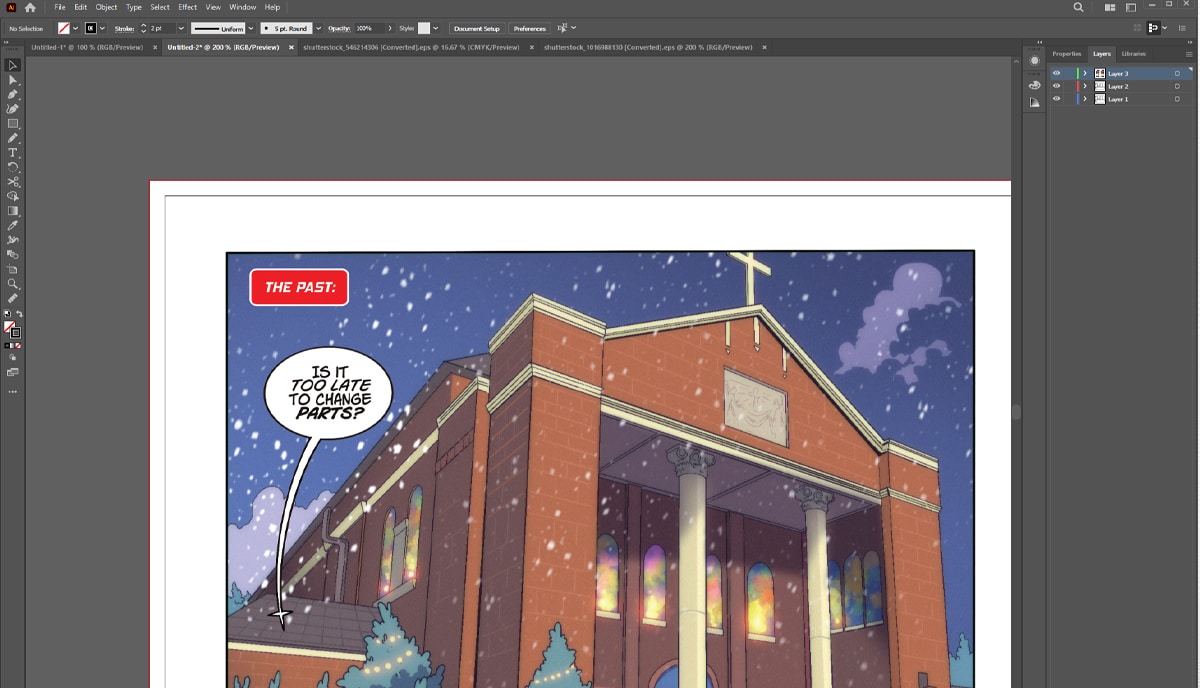
Once you've completed all the creative, artistic work, you'll need to get to grips with the technical side of things. Now, you can pay an experienced graphic designer to do all this for you if you have the money and you can find someone with the relevant skills and experience and whom you feel confident that you can trust. Or, you can go for it and do it yourself. If you print your graphic novels with us, we have a significant package of useful tools, such as layout templates for both the interior pages and the covers, free file checking, expert design support, and a named, one-to-one consultant to help you through the entire process. So, what's involved in designing and printing your graphic novel series?
Design software and tools
To create a professional-looking graphic novel, you'll need to use design software like Adobe Illustrator, InDesign, Affinity Publisher, or Clip Studio. These tools allow you to import your illustrations, arrange panels, and add text, and also use layers and define bleed zones, trim lines, spine width, and more, ensuring that your final product is polished and ready for printing. Not sure what all of that means? Don't worry. We understand all of this technical stuff inside out and back to front; and we're here to help you every step of the way.
Preparing your files for printing
Before sending your graphic novel off to be printed, you'll need to prepare your files correctly. This includes selecting the color space, ensuring your images are high resolution, and generating a print-ready PDF. You'll need to choose the right paper both for the interior pages and the cover, any special finishes, and the binding style.
The reproduction quality of your graphic novel's artwork is a vital aspect of its potential success. No matter if you've created something ironic, or a page-turning adventure, or a deeply philosophical narrative, the artwork must be stunning and captivating to the eye. You won't want to lose anything of the original impact of your work when transferring it to print. So, here are several helpful tips to guide how you prepare your digital files for the printer.
- For optimum results, export your files as vectors in print-quality PDF format. We recommend Adobe Illustrator or Adobe InDesign as the software of choice for preparing graphic novels. For offset printing, you must convert your color space from RGB to CMYK.
- If you must export images as bitmaps, make sure they resolve to at least 300 DPI. With vectors, you needn't worry about resolution, but all other images must have a high definition to tolerate resizing without becoming fuzzy and “pixilated”.
- Add a “bleed zone” of 3 mm around all your pages. A bleed zone is an area at the edge of your artwork, which falls outside your finished artwork. Once we've printed your pages, we'll cut them to the exact size needed for your chosen graphic novel format. This “bit extra” gets cut off and makes sure that the finished image fills the page with none of it being lost. Mark bleed zones as red lines.
- Inside your bleed zone, mark the “trim lines”. These should be green and show the final dimensions of the finished page. Make sure that any necessary elements of your images stop at least 4 mm short of the trim line so they don't get cut off.
- If your novel has “splash pages” or artwork which crosses a spread, make sure none of the essential elements — like your protagonist's face! — fall over the center crease.
If you're collaborating with an experienced graphic designer to generate your files, they will know what's needed to get things “print ready”. But if you're working independently with design software for the first time, these are helpful tips to consider before submitting your files. But remember, if you print your graphic novel with us, our team of experts will always manually check all your files before we go to press. If we find any issues, we'll let you know and help you resolve them. We won't print your graphic novel until we're 100% sure we'll get a perfect result. And our friendly, expert team will be just a phone call, an email, or a Skype call away throughout the process, ready to help and advise you at every step.
Graphic novels and crowdfunding
Unlike several other printing companies who may only be interested in the revenue, we genuinely care passionately about all our clients and appreciate the long hours of intensive creative work that go into creating a graphic novel from the first inkling of inspiration to the final printed product. We want not only to print your books, we want to support you to make them succeed. That's why we have special offers if you're an independent publisher or run a small press.
Kickstarter has become the go-to crowdfunding site for comic book and graphic novel creators around the globe. So much so, that graphic novel fans often go there as the first port of call when looking for fresh talent or the latest offering from their favorite authors, artists, and series. If you're running a crowdfunding campaign on Kickstarter, talk to us first. We'll be happy to help you with free graphic novel interior and cover design templates, free artwork checking, and special discounts on a range of optimal printing solutions.
Choosing the right printer
Selecting the right printer for your graphic novel is essential to ensure a high-quality final product. Look for a printer with experience in handling graphic novels and who offers printing options that suit your needs, such as perfect binding, high-gloss cover finishes, and standard graphic novel trim sizes. Digital printing or POD (print-on-demand) may seem attractive at first sight—and you should certainly explore all options before deciding—but it isn't the best or most economical solution for most graphic novels.
Digital printing can't give you the faithful, high-quality color reproduction that most graphic novels need and deserve. Nor do most print-on-demand services handle hardcover binding or larger formats, which are often vital for a successful graphic novel. Digital printing is relatively economical for short runs, but if you need to print between 100 and several thousand copies of a professional level book, you will make huge savings printing with an offset printer like QinPrinting.
You should also consider the attitude and approach of the company. When working on a creative project, dollars aren't everything. You should be sure that the people you're printing your book with share your passion and are truly committed to a personal level of customer care.
Publishing your graphic novel
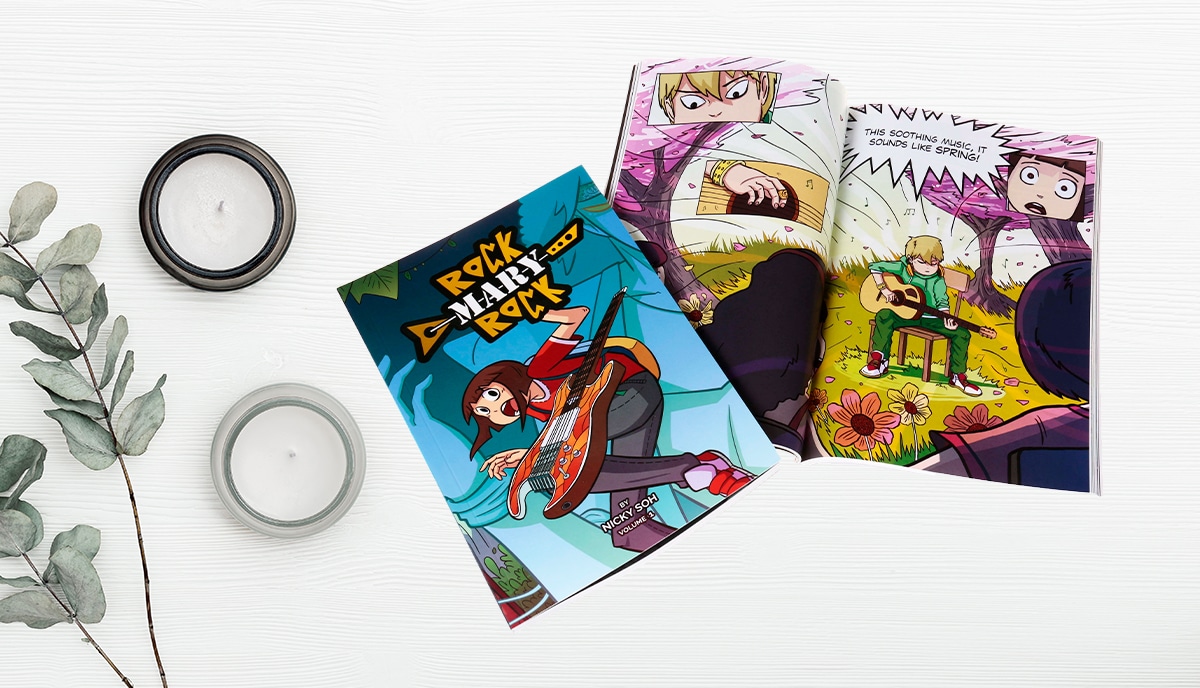
But printing your novel is not the same as publishing it. To sell your graphic novels, you'll need to publish and market them, too. In part, your Kickstarter campaign supporters will get the ball rolling as you distribute their copies and they leave you reviews. This is assuming that you're self-publishing. But you might also want to take the traditional publishing route. In which case, you'll need to find an agent to represent your work to the publishers, negotiate your contract, and so on. But you'll still need to do a lot of marketing on your own as these days, few publishers have the resources to do much through promotion except for a very few books by already-established authors. So, let's dive into the complexities of self-publishing your graphic novel series next.
How to self-publish a graphic novel series
With publishing your graphic novel, you have two main options: traditional publishing or self-publishing. Both have their pros and cons, so carefully consider factors like creative control, advances, royalties, and promotional support when making your decision. But we won't go into great detail about the mainstream option here as we are primarily concerned with helping those who have already made up their minds to follow the self-publishing route and probably through a Kickstarter crowdfunding campaign.
Why? Well, we have nothing against mainstream publishing—we print books for several mainstream publishing houses!—but we also know that in the world of comic books and graphic novels, even among established authors, the future probably lies in independent publishing which continues to grow and go from strength to strength.
There are several reasons this is happening, but the core development has been how the Internet has allowed creators and fans to establish direct, mutually sustaining relationships without the need of “middle men”. Aside from crowdfunding sites like Kickstarter and the social media, investment portals such as Patreon and Ko-Fi have changed the way many creators operate and allowed fans and appreciators to support the artists and writers they best love.
We think this is a good thing and opens doors to young and upcoming creatives that would formerly have remained closed to them. And as a printing company specializing in creative work and supporting independents, we love that! So, let's explore how to navigate the world of self-publishing graphic novels.
Navigating the world of self-publishing graphic novels
Self-publishing offers greater creative freedom, personal satisfaction, and potentially higher financial gains than mainstream publishing. It's also faster and more responsive. But it also requires more effort on your part and a slightly greater investment in terms of marketing and promotion.
While platforms like Lulu, BookBaby, and Kindle Direct Publishing (KDP) are popular options for self-publishing standard novels in the bestselling genres such as romance, crime, and erotica, graphic novels demand a different treatment with a wider range of options and customization than these limited services can provide. If you are just starting out as a text-based novelist, they might be right for you. But they can't handle the technical, artistic, and material requirements needed to print a competitive graphic novel. That's why you should look to an offset printer with knowledge and experience in the field. That's us, by the way!
Marketing and promoting your graphic novel
The first two steps in self-publishing your graphic novel series are the easiest: you create your novel and you get it printed. You may begin marketing simultaneously by running a crowd funder, which both finances initial production and generates a community around your project. But then you need to publish your work. And that means getting it out there, getting eyeballs on it, and getting folks to part with their hard-earned dollars (or euros or pounds or yen or whatever) to read it. To do that, you must:
- Build your brand and presence
- Build a community around your work
- Establish distribution and retail channels
- Garner reviews and build buzz
- Keep the momentum going by expanding the series
With those bullet points in mind, let's look at what may be involved in marketing, promoting, and selling your graphic novels series.
Building your brand and online presence
As an independent creative, you are your brand. Most fans want to have regular engagement with the creator behind the work they love. So, while you needn't try to do all the following, pick two or three that you genuinely enjoy and develop them with regular content updates and engagement:
- Maintain a social media presence on platforms like Twitter, Facebook, Instagram, and more
- Start a YouTube channel where you discuss your ideas, processes, and show work-in-progress
- Curate a website and blog to showcase your work and discuss topics of interest to your readers (you can also sell your books directly from your website)
- Make sure you have an up-to-date author page on Amazon and other online retailers
- Seek out opportunities to write guest posts on relevant blogs
- Send out press releases about your graphic novel series
- Do a blog tour and offer interviews
- Approach podcasters for a slot on a related show
- Establish relationships with fans and other creators on platforms like Patreon, Ko-Fi, and Goodreads and run regular Q&As
Make sure that you use the same profile image across all media and platforms so that you emphasize your brand identity and become known and recognizable. Likewise, pick and use a consistent color scheme for all your profiles, web designs, and content—obviously in keeping with your core graphic novel series. All these activities help to establish your brand and boost your visibility across the Internet and beyond. And by engaging regularly, you'll build trust, establish authority, make sales, and gain followers. So, now let's look at how to build a community around your work so that you can guarantee increased future sales of your books.
Building a community around your work
There are two approaches to building a community around your work as a graphic novel creator: online and offline. Depending on your personality, skills, resources, mobility and other factors, you may wish to focus on one or the other or both. Either way, building an engaged community around your work is a vital component of successful graphic novel marketing and promotion.
We've covered a lot of the online activities you'll need to engage with above—social media, website, blogs, podcasts, forums, and online stores—but there's another vital component to this which is directly related to building your community and making sales: and that's your email list. It's become a marketing cliché to say that “the money's in the list” but that's only because it's true! You should get your email list set up—using a provider such as MailChimp, ConvertKit, Aweber, or Constant Contact—as early in the process as possible.
Not only that, but make sure that you have both a live link to your email signup and an unequivocal call to action asking potential follows to get on that list. You can choose to reward sign-ups by offering a freebie to new subscribers. That could be a discount code for your graphic novel, say, or a digital product such as an ebook (a simple PDF download will do the job) with maybe added artwork or deleted scenes. Once you have fans on your list, you can communicate with them directly. Let them be the first to know about new releases, solicit reviews, and make sales.
In terms of outreach offline, comic conventions and other related events provide excellent opportunities to showcase your work, network with industry professionals, and connect with potential readers. Rent a table to display your graphic novels, and invest in eye-catching promotional materials like posters, bookmarks, art cards, flyers, brochures, and more to stand out from the crowd and get your brand message out of the concourse and into the world. And, of course, you can get people to sign up to your email list there, too! Other options to investigate might be book signings in high-street bookstores, a talk and Q&A tour in libraries, a workshop for art colleges, and other venues where you may find people enthusiastic about your graphic novels.
Establishing distribution and retail channels
As your graphic novel is a physical product, distribution and retail is a little more complex than for a text author who has the option to distribute only electronic copies of their books via Amazon, Smashwords, B&N, and so on, for downloading and reading on e-readers such as the Kindle, Kobo, and Nook. Before you complete your book's design, you'll need to anticipate getting it into physical and online bookstores, libraries, and other mainstream channels.
To do that, you'll need an ISBN (International Standard Book Number) and a barcode. In the US, you can buy ISBNs via Bowker, in the UK from Nielsen, and most other countries have their equivalent organizations authorized to generate, distribute, and manage the ISBN system. Once you have your ISBN, you can generate a barcode using proprietary software or your professional graphic designer will do it for you.
Once you have registered your barcodes with your national authorities, they are then linked permanently to your books. Stores and libraries can then access all the information and metadata that you associate with them at the point of registration simply by scanning the barcode on the cover or in a catalog, for example. For a small fee, you can get your books listed in the national catalogs from which stores and libraries order their stock.
Another effective way to get your book to retail is to take a few copies to specialist comic and graphic novel stores, and also to libraries, and ask if they'll stock them for you on a sale or return basis. Many independent stores will accept a few copies for a reasonable percentage of sales. If your books sell, they'll almost always ask you for more.
Besides live events, the two primary sales routes for you as an independent publisher will be via the online stores, of which the biggest and most successful at the time of writing is Amazon, and directly to readers via your email list. Amazon has storage, fulfillment and distribution options for physical books available to self-published authors at a range of service levels and price points. But you should always build your list. Whatever else you do to market and promote your graphic novels, always look for the opportunity to build your list.
Garnering reviews and building buzz
If you are doing any selling online—and you really should!—then reviews, both in terms of quality and quantity, will be vital to your success. So you should proactively solicit reviews at every reasonable opportunity. Encourage readers to leave reviews for your graphic novel, as this can help generate buzz and increase sales. Consider offering a few free copies for honest reviews, or reach out to relevant influencers, bloggers, and reviewers within the graphic novel community. And, of course, there's your mailing list.
Expanding your graphic novel series
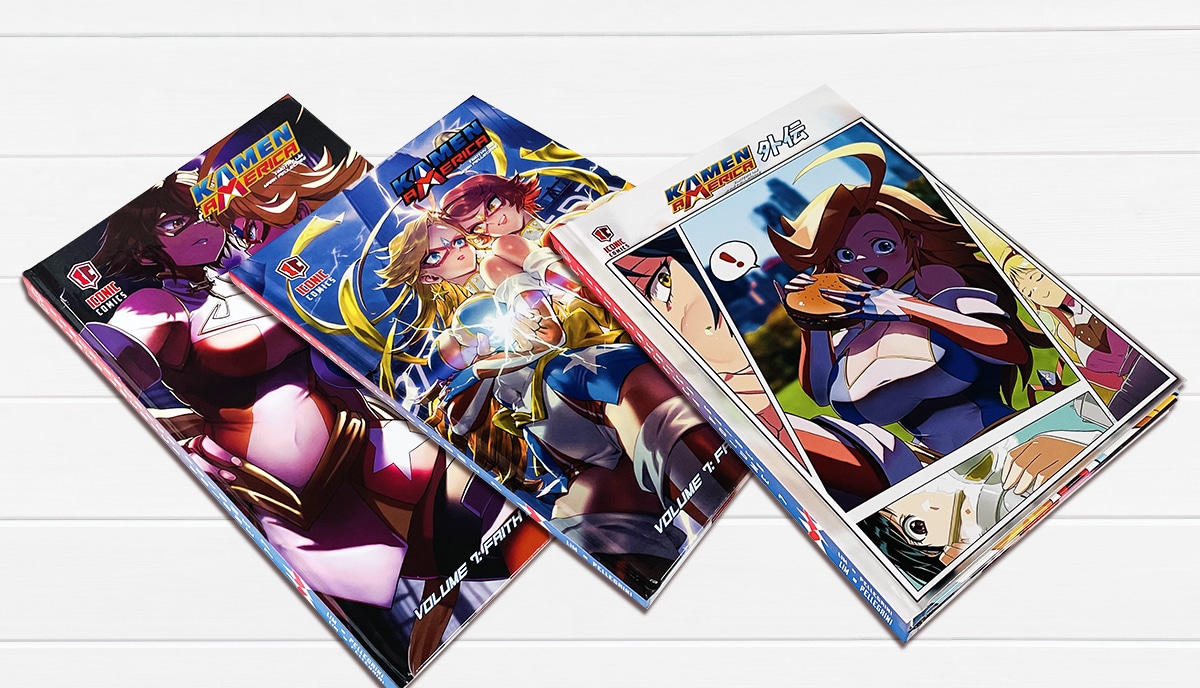
One of the established facts of independent publishing is that series always outsell one-offs and that you usually need at least three books in your series before you'll see significant traction. So don't waste time constantly rechecking your sales stats hoping to see a boost in sales: crack on with the next book in your series.
As your core series of graphic novels gains traction, you may wish to produce a box set, and then expand your series with spin-offs or change the focus to different characters based on what your email subscribers tell you they've most enjoyed. Keep your fans engaged by promoting upcoming releases and offering pre-order incentives like exclusive artwork, collectible bookmarks, or limited-edition prints to boost subscriptions. Continually work on building your fan base—and your email list—by engaging with readers both online and in person. Maintain an active presence on social media, attend conventions and events, and collaborate with other artists and writers to expand your network and reach new audiences.
Ready to rocket launch your graphic novel series? Let's talk!
Creating a successful graphic novel series is a labor of love, requiring passion, patience, and persistence. Embrace the journey, learn from your experiences, and never stop pushing the boundaries of your creativity. But with the right attitude, a business plan, and a reliable relationship with a reputable and experienced printer, you can turn that passion into a full or part time business doing what you love. By following these steps and tips, you'll be well on your way to designing, printing, publishing, and selling a successful graphic novel series. Remember that success is a journey, and with dedication and hard work, you'll be able to bring your unique stories and characters to life, captivating readers and leaving a lasting impact on the world of graphic novels. Whether you're just starting out or you're looking to build on your past success, we'd love to work with you on developing your graphic novel series. Get in touch to discuss your ideas and we'll tell you how we can help.





